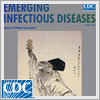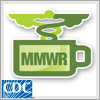Digital Press Kit
CDC 2012: A Year in Review
CDC is known for outbreak response. We're known for being the first there, the best there, and being able to support our local and global partners in identifying problems and stopping them. We have America's back; we work to protect Americans from threats 24/7 and we work to help people lead longer, healthier, more productive lives by preventing heart attacks, cancer, stroke, diabetes and other leading causes of death.
Here’s a highlight of how CDC has been there for America and the world in 2012:
- Multistate Fungal Meningitis Outbreak - CDC in collaboration with state and local health departments and the Food and Drug Administration (FDA) , is investigating a multistate outbreak of fungal meningitis and other infections among patients who received contaminated preservative-free MPA steroid injections from New England Compounding Center (NECC). Several patients suffered strokes that are believed to have resulted from their infections. The investigation also includes other infections from injections in a peripheral joint, such as a knee, shoulder, or ankle.
- West Nile Virus - CDC works with state and local health departments and other government agencies, as well as private industry, to prepare for and prevent new cases of West Nile virus (WNV). There have been 5,387 human disease cases of WNV reported as of the second week in December; 2012 is probably the second largest outbreak of WNV since it first appeared in the United States in 1999. By comparison in the past 10 years there have been 2,845 cases of human WNV reported during the same time period. CDC will produce a full report of cases and deaths for release in the spring of next year, while continuing to manage and maintain ArboNET—a nation-wide electronic surveillance system where states share information about WNV and other arboviral diseases. Supporting states to develop and carry out improved mosquito prevention and control programs is also a priority for CDC.
- Healthcare-Associated Infections - More than 150,000 patients have been impacted by unsafe injection practices since 2001; causing irreparable damage by exposing patients to bloodborne illnesses, such as hepatitis and HIV, and to life-threatening bacterial infections. CDC routinely identifies and investigates outbreaks associated with deficient practices, and through targeted education and awareness efforts, the One & Only Campaign empowers patients and healthcare providers to insist on nothing less than safe injections – every time, for every patient.
- Foodborne Illnesses - CDC scientists monitor up to 40 potential foodborne disease clusters on a weekly basis throughout the year and investigate more than 200 multistate clusters of foodborne illness. One of the newest and most promising programs in detecting these outbreaks is the FoodCore program which performs comprehensive foodborne disease surveillance and conducts rapid, coordinated detection and response to multistate outbreaks in seven locations nationally.
- Ebola – On July 28th, 2012, the Uganda Ministry of Health reported an outbreak of Ebola Hemorrhagic fever in the Kibaale District of Uganda. A total of 24 human cases (probable and confirmed only), 17 of which were fatal, have been reported since the beginning of July. Laboratory tests of blood samples, conducted by the Uganda Virus Research Institute (UVRI) and the U. S. Centers for Disease Control and Prevention (CDC), confirmed Ebola virus in 11 patients, four of whom have died. On October 4, 2012, 42 days after the last human case, the Uganda Ministry of Health declared the outbreak ended.
- Rabies – Some people living in two Amazon communities in Peru survived being exposed to the rabies virus by naturally fighting it off. While avoiding rabid animal exposures and receiving shots after a person is exposed to the rabies virus is the best way to avoid getting this fatal disease, there is strong evidence that an immune response may occur in certain communities where people are regularly exposed to the virus.
- Influenza - The United States is seeing the earliest flu season in nearly a decade, but CDC survey data through mid-November indicate that more than half of the population of the United States has not gotten a flu vaccine, leaving them vulnerable to infection possibly serious illness and to passing their illness on to others. CDC is committed to increasing awareness about the dangers of influenza and adherence to vaccine and early treatment recommendations, especially among people who are at greater risk for serious flu complications if they become ill.
- Polio – Polio eradication is one of the highest priorities for CDC. Activation of CDC's Emergency Operations Center (EOC) earlier this year has reduced the number of polio cases greatly, and with continued agency support and CDC’s partnership with the Global Polio Eradication Initiative (GPEI), we have become closer than ever to eradicating polio.
- TIPS from FORMER Smokers - CDC launched the groundbreaking Tips From Former Smokers national ad campaign on March 15, 2012, to increase awareness about the human suffering caused by smoking and to encourage smokers to quit. During the 12-week campaign, calls to the national quitline 1-800-QUIT-NOW and visits to smokefree.gov documented record volume. Building on the success of the TIPS campaign, new advertisements will be launched in 2013.
- Prescription Drug Overdose- Prescription painkiller were involved in more than 16,600 overdose deaths in 2010. This is more than four times the number of deaths in 1999. CDC has taken steps to respond to the abuse of prescription drugs by tracking abuse and overdose trends, working with stakeholders to improve clinical care, and evaluating the impact of efforts to prevent overdoses.
- Hurricane Sandy - CDC’s National Center for Environmental Health (NCEH) plays a key role in preparing the nation for all types of public health threats, including natural disasters like hurricanes. When a disaster occurs, NCEH is prepared to respond and supports national, state, and local partners to save lives and reduce suffering, while helping these partners recover and restore public health functions after the initial response. In late 2012, NCEH played a role in responding to Hurricane Sandy by delivering accurate and timely preparedness and response information to the public, our partners, and the media by using the web, social media, and traditional media.
- NFL Study on Traumatic Brain Injury – CDC’s National Institute for Occupational Safety and Health has a long partnership with the National Football League (NFL) to study health risks to players. A new 2012 study found that NFL players may be at a higher risk of death from diseases such as Alzheimer’s and ALS (Lou Gehrig’s disease) than the general U.S. population. Although the players’ risk of death from all causes was comparatively lower, death involving neurodegenerative causes was more than three times higher than in the general U.S. population. In addition, when line and non-line positions were compared, non-line position players (or “speed” players) had a higher risk of neurodegenerative death than linemen.
- Sleep Deprivation Study - Insufficient sleep can have serious and sometimes fatal consequences for fatigued workers and others around them. The CDC’s National Institute for Occupational Safety and Health reported on the issue in a MMWR report published in April 2012, finding that the prevalence of short sleep duration varied by industry of employment with a significantly higher rate among workers in the manufacturing industry compared with all U.S. workers combined. Targeted interventions, such as shift systems that maximize sleep opportunities and training programs on sleep for managers and employees, should be implemented to protect the health and safety of workers and the public.
Multistate Fungal Meningitis Outbreak
“We are working tirelessly with our state public health partners to track down patients who may have received these medications. If patients are identified soon and put on appropriate antifungal therapy, lives may be saved.”
-Benjamin J. Park, MD, State Response and Surveillance Team Lead for the Multistate Fungal Meningitis Outbreak and Chief Epidemiologist with the Mycotic Diseases Branch, CDC
West Nile Virus
“It is not clear why we are seeing more activity than in recent years. Regardless of the reasons for the increase, people should be aware of the West Nile virus activity in their area and take action to protect themselves and their family.”
-Marc Fischer, M.D., M.P.H., medical epidemiologist with CDC’s Arboviral Diseases Branch
Healthcare-Associated Infections
“The three-point rule is simple: Use needles, syringes, and single-dose medication vials only one time, for one patient. Patients and healthcare providers must insist on these infection control basics to avoid serious infections.”
-Joseph Perz, DrPH, MA, epidemiologist, Division Of Healthcare Quality Promotion, CDC
Foodborne Illnesses
“As our food supply becomes more global, people are eating foods from all over the world, potentially exposing them to germs from all corners of the world, too. We saw an increased number of outbreaks due to imported foods during recent years, and more types of foods from more countries causing outbreaks. We need better - and more - information about what foods are causing outbreaks and where those foods are coming from. Knowing more about what is making people sick, will help focus prevention efforts on those foods that pose a higher risk of causing illness.”
-Hannah Gould, Ph.D., an epidemiologist in CDC’s Division of Foodborne, Waterborne and Environmental Diseases
Ebola
“2012 has been a very interesting year for filovirus (Ebola and Marburg). The outbreak above was only the first of four outbreaks in a row: Ebola in Kibaale in July, Ebola in Isiro (Democratic Republic of Congo) in August, Marburg in Kabale (Uganda) in October, and Ebola in Luweero (Uganda) in November. All were first diagnosed in the CDC-UVRI laboratory in Uganda. Scientists from the Viral Special Pathogens Branch in Atlanta and Entebbe provided laboratory, epidemiological, and ecological support in the field and at the CDC-UVRI laboratory.”
-Pierre Rollin, MD, Deputy Branch Chief, Viral Special Pathogens Branch, CDC
Rabies
“Nearly all rabies virus exposures that proceed to clinical infections are fatal. Our results support the idea that under very unique circumstances there may be some type of enhanced immune response in certain populations regularly exposed to the virus, which could prevent onset of clinical illness. However, a series of injections following an exposure remains the best way to protect people against rabies.”
-Amy Gilbert, PhD, of CDC’s National Center for Emerging and Zoonotic Infectious Diseases
Influenza
“Flu is a potentially serious disease, but many people either don’t recognize that or feel they are not vulnerable. We are trying to get the message out there that flu can be serious to anyone, but that it’s especially dangerous for certain people, like young children, pregnant women and the elderly, for example. So even if you are perfectly healthy and not worried about yourself, you might think about the people you are in contact with who could have more trouble. Get vaccinated both to protect yourself and to protect those close to you.”
-Dr. Suxiang Tong, team lead of the Pathogen Discovery Program in CDC’s Division of Viral Diseases
Polio - Stop Transmission of Polio (STOP) Program
“New data from Pakistan show that of the two types of wild polio virus (WPV1 and WPV3) circulating in the country, WPV3, also known as Type 3, is close to being eliminated. There have not been any Type 3 cases reported for six months, which is the longest gap in incidence there to date. CDC works with Pakistan officials to monitor different chains of transmission over time and Type 3 is now down to only one chain, which is an indication that we are close to breaking the last link of Type 3.”
-Steven Wassilak, MD, a medical epidemiologist and polio expert at the Global Immunization Division at CDC’s Center for Global Health
TIPS from FORMER Smokers
“These ads have helped smokers quit and will ultimately save lives and decrease the huge economic burden caused by tobacco use. The people in the ads are national heroes—they are willing to tell their stories, despite the personal cost, because they don’t want to see it happen to anyone else.”
-Tim McAfee, M.D., M.P.H., director of CDC’s Office on Smoking and Health
Prescription Drug Overdose
“Methadone continues to play an important role in substance abuse treatment and should not be limited in its use for that application. Health care providers can take precautions to reduce the risks of methadone overdose when used for treating pain.”
-Linda C. Degutis, Dr.P.H., M.S.N., director of CDC′s National Center for Injury Prevention and Control
Hurricane Sandy
“Just like in those super storms, we’re seeing individuals who’ve lost everything and we’re seeing large-scale damage. I met a 96-year-old man who mowed his lawn up until the day Hurricane Sandy hit New Jersey. He said resiliency was his secret to living to 96 and that he wasn’t going to let anything get him down, and I’m not even sure he has a home to go back to.”
-CAPT Michael Toedt, MD, Rapid Deployment Force (RDF) lead
NFL Study on Traumatic Brain Injury
“Multiple research studies have raised concerns about the longer-term health effects of recurring concussions. Our research may help provide further insight into the issue of brain disease and mortality, which is a great concern of the professional football community.”
-Everett Lehman, MS, Deputy Division Director, NIOSH’s Division of Surveillance, Hazard Evaluations & Field Studies
Sleep Deprivation Study
“About 41 million working U.S. adults get less than the recommended amount of sleep,” says Dr. Sara Luckhaupt, MD, at NIOSH’s Division of Surveillance, Hazard Evaluations, and Field Studies. “This increases the risk of workplace injuries and leads to poor job performance and decreased productivity as well as leading to more chronic health problems such as heart disease, diabetes, obesity, and depression. There are things workers can do to improve their sleep hygiene, including going to bed at the same time each night (or day) and getting up at the same time, and not exercising or eating a big meal right before going to sleep.”
-Sara Luckhaupt, MD, Medical Officer, NIOSH’s Division of Surveillance, Hazard Evaluations, and Field Studies
- Multistate Fungal Meningitis Outbreak - CDC Responds to Multistate Meningitis Outbreak
- West Nile Virus - West Nile virus disease cases up this year
- Influenza - Seasonal Influenza (Flu)
- Healthcare-Associated Infections - The Impact of Unsafe Injection Practices in U.S. Healthcare Settings
- Foodborne Illnesses - CDC research shows outbreaks linked to imported foods increasing | Majority of dairy-related disease outbreaks linked to raw milk
- Ebola - Ebola in Uganda
- Rabies – Study Detects Rabies Immune Response in Amazon Populations | CDC: Amazon study finds routine rabies exposures
- Polio - Stop Transmission of Polio (STOP) Program
- TIPS from FORMER Smokers - Calls to quitline hit record high after CDC national tobacco ad campaign launch | Tips from Former Smokers Share Harsh Realities | Landmark ad campaign yields almost 200,000 more calls to state quitlines after 12 weeks
- Prescription Drug Overdose - Methadone linked to 30 percent of prescription painkiller overdose deaths | Vital Signs: Prescription Painkiller Overdoses- Use and Abuse of Methadone as a Painkiller
- Hurricane Sandy - Up and Running in 48 Hours: How Federal Medical Stations Help People After Natural Disasters Like Hurricane Sandy
- NFL Study on Traumatic Brain Injury - Saving Lives and Protecting People: Preventing Traumatic Brain Injuries (TBI) | Neurology journal paper: Neurodegenerative causes of death among retired National Football League players
- Sleep Deprivation Study - MMWR: Short Sleep Duration Among Workers — United States, 2010
CDC Resources:
- CDC Facts
- National Center for Emerging and Zoonotic Infectious Diseases
- Global Health
- Tips From Former Smokers
- National Center for Injury Prevention and Control
- Saving Lives and Protecting People: Preventing Prescription Painkiller Overdoses
- National Center for Environmental Health
- Emergency Preparedness and Response: What CDC is Doing
- The National Institute for Occupational Safety and Healt (NIOSH)
- CDC 24/7
General Resources:
- Digital Press Kit Archives
- CDC Press Release and Media Advisory Archives
- CDC TV
- Social Media
- Podcasts
- Executive Leaders and Bios
Additional Resources:
CDC works 24/7 saving lives and protecting people from health threats to have a more secure nation. Whether these threats are chronic or acute, manmade or natural, human error or deliberate attack, global or domestic, CDC is the U.S. health protection agency.
CDC Media Relations
(404) 639-3286
media@cdc.gov
Spokesperson
Thomas R. Frieden, MD, MPH
CDC in Action


Multistate Fungal Meningitis Outbreak
Fungal Infection Outbreak: What Should Physicians Be Doing?

Author: Tom M. Chiller, MD, MPHTM
Date: 10/31/2012
Fungal Infection Outbreak: What Should Physicians Be Doing?
West Nile Virus
Healthcare-Associated Infections


Foodborne Illnesses
Rabies
Rabies Elimination in the 21st Century

Author: Centers for Disease Control and Prevention
Date: 1/22/2011
Rabies Elimination in the 21st Century
Influenza
Warning Signs: Seasonal Flu

Author: Centers for Disease Control and Prevention
Date: 9/27/2010
Warning Signs: Seasonal Flu
TIPS from FORMER Smokers
CDC: Tips from Former Smokers - Anthem Ad

Author: Centers for Disease Control and Prevention
Date: 3/15/2012
CDC: Tips from Former Smokers - Anthem Ad
Prescription Drug Overdose
Hurricane Sandy
Sleep Deprivation Study
Get email updates
To receive email updates about this site, enter your email address:
Contact Us:
- Centers for Disease Control and Prevention
1600 Clifton Rd
Atlanta, GA 30333 - 800-CDC-INFO
(800-232-4636)
TTY: (888) 232-6348 - Contact CDC-INFO























